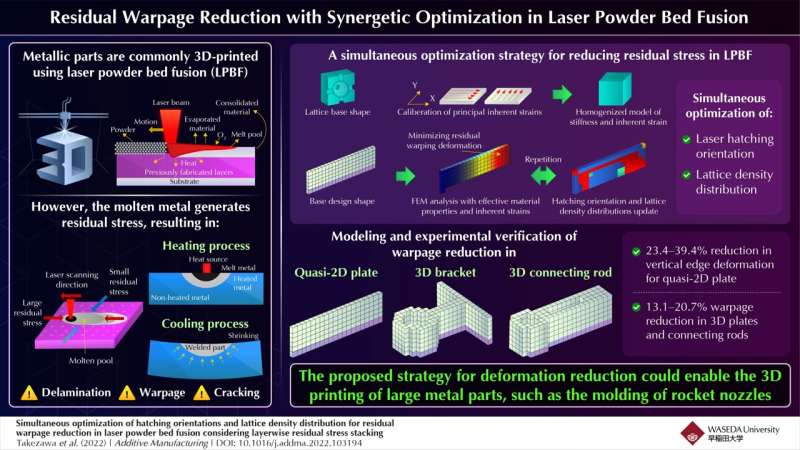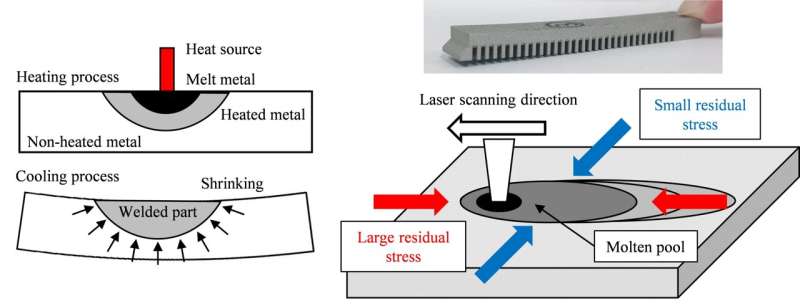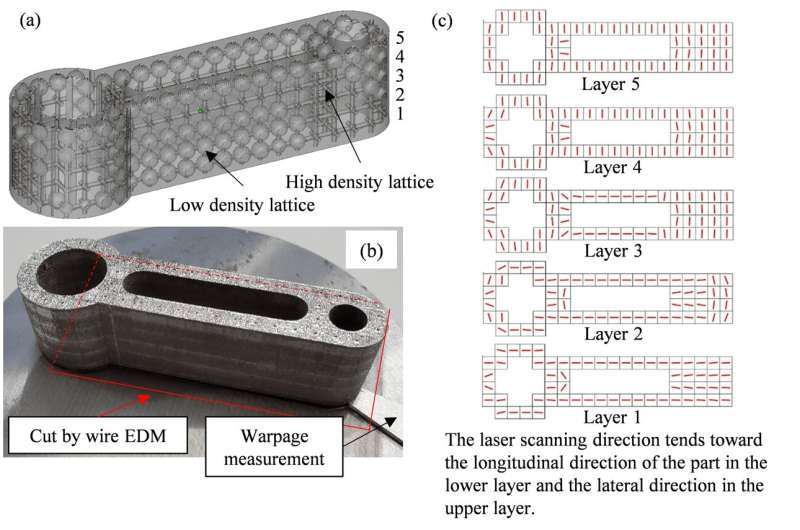
In additive manufacturing (AM), metal parts are commonly 3D-printed using a fabrication technique called “laser powder bed fusion” (LPBF). LPBF involves repeated rapid metal powder melting and solidification using a laser heat source to form a 3D object. The local high-temperature molten metal fits the surrounding solid part owing to thermal expansion.
However, the molten metal generates a negative thermal stress following solidification, which produces an in-plane residual stress. This residual stress accumulates toward the upper layer with the repetitive formation process on each layer and often leads to undesirable effects like delamination, cracking, and warpage. Moreover, residual warpage and deformation are asymmetric in nature and scale with the size of the fabricated metal part. As a result, the integrated molding of large metal parts, such as rocket nozzles, is extremely challenging.
To tackle this issue, a team of researchers from Japan and the U.S., led by Professor Akihiro Takezawa from Waseda University, have now proposed an optimized design strategy for AM. “LPBF metal 3D printing, which has been the focus of much attention in recent years, suffers from large warping of molded parts. In this study, we developed a method to reduce residual deformation by simultaneously optimizing the internal structure of the fabricated part and the laser scanning direction,” explains Takezawa.

In their study made available online in Additive Manufacturing, the team, including Dr. Qian Chen and Professor Albert C. To from University of Pittsburgh, U.S., studied the reduction of residual warpage while focusing on layer-wise residual stacking and utilized the lattice infill distribution technique.
They employed a numerical methodology called “recurrent formula inherent strain method” to analyze the residual deformation. In this, they modeled the lattice based on the effective stiffness and anisotropic inherent strain using a gradient-based optimization algorithm.
In LPBF AM, the team simultaneously optimized two aspects of the fabrication process: the laser “hatching orientation” or scanning direction that utilizes the asymmetry of residual stress, and the internal structure of the fabricated material or the “lattice density distribution” by considering layer-wise residual stress stacking. Accordingly, they fine-tuned their methodology to ensure the synergetic influence of simultaneous optimization.

In addition, the team performed experiments to verify their novel methodology using quasi-2D plates, 3D brackets, and 3D connecting rods. Compared to the standard benchmark designs in use, their design strategy reduced vertical edge deformations by 23–39% in quasi-2D plates. In the cases of 3D brackets and connecting rods, the warpage reductions ranged between 13–20%.
Overall, the methodology proposed in this study could herald a remarkable development in 3D printing using LPBF fabrication. Reduction in residual warping and deformation is critical to molding large metal components. “Recent improvements in metal 3D printing technology have made it possible to produce larger molded parts. In this light, our methodology should ideally enable 3D printing of any large metal part,” concludes Takezawa.
Akihiro Takezawa et al, Simultaneous optimization of hatching orientations and lattice density distribution for residual warpage reduction in laser powder bed fusion considering layerwise residual stress stacking, Additive Manufacturing (2022). DOI: 10.1016/j.addma.2022.103194
Citation:
Synergetic optimization for reducing residual warpage in laser powder bed fusion (2022, November 1)
retrieved 1 November 2022
from https://techxplore.com/news/2022-11-synergetic-optimization-residual-warpage-laser.html
This document is subject to copyright. Apart from any fair dealing for the purpose of private study or research, no
part may be reproduced without the written permission. The content is provided for information purposes only.
Stay connected with us on social media platform for instant update click here to join our Twitter, & Facebook
We are now on Telegram. Click here to join our channel (@TechiUpdate) and stay updated with the latest Technology headlines.
For all the latest Technology News Click Here
For the latest news and updates, follow us on Google News.
